Musalla Complex
Musalla complex (also called Musallah Complex, Musalla of Gawhar Shad) is a large former Islamic religious complex located in Herat city in western Afghanistan. The 15th century complex is in ruins today. The complex ruins consist of the five huge 55 metre (180 feet) Musallah Minarets of Herat, mausoleums of Mir Ali Sher Navai, Sultan Husayn Mirza Bayqara and the ruins of a large mosque and Islamic madrasa school buildings. The complex was begun in 1417 by Queen Goharshad Begum, the wife of Timurid ruler Shah Rukh who established Herat as the capital of the Timurid Empire.[1]
 Remains of Musalla Complex seen on 2005. | |
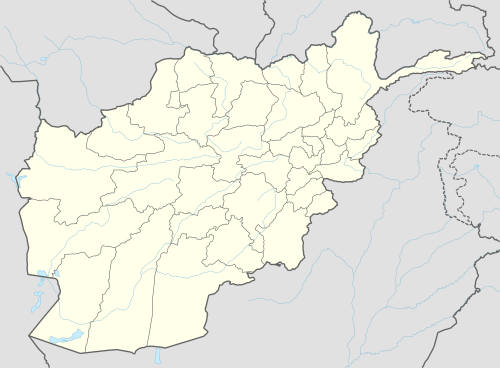 Herat Location in Afghanistan | |
| Alternative name | Musallah complex, Gauhar Shad Musallah |
|---|---|
| Location | Herat, Afghanistan |
| Region | Herat Province |
| Coordinates | |
| Type | Islamic religious complex |
| Height | 55 m (180 ft) minarets |
| History | |
| Builder | Queen Goharshad of Timurid Empire of Herāt. |
| Founded | 1417 |
| Abandoned | 1885 |
| Cultures | Islamic |
| Events | 1885 destruction by British. |
| Site notes | |
| Condition | Ruined |
| Public access | Yes |
| Architecture | |
| Architectural styles | Timurid |
| Architectural details | Timurid Mosque, Shah Rukh madressa, mausoleums, 20 minarets, |
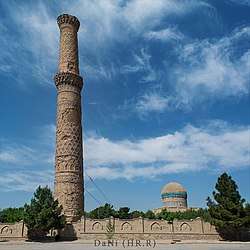
History
It is thought that a madrasa was built in 1417 and a mosque was then built in 1426.[1] Sultan Husain's Madrasa was most likely built around 1493 (898 A.H.). The site contains examples of Timurid architecture although it has been heavily damaged, first by artillery fire in 1863, then during the Panjdeh incident of 1885 when most of the ruins were razed in an attempt to prevent its use as a base by the invading Russian army. Finally, an earthquake in 1932 destroyed two of the mosque's four minarets.[1]
The site rose to the attention of Europeans when it was visited and photographed in the 1930s by the travel writers Robert Byron and Annemarie Schwarzenbach. Byron's book, The Road to Oxiana mentions the minarets and discusses Timurid history.
Preservation
Some emergency preservation work was carried out at the site in 2001 which included building protective walls around the Gawhar Shad Mausoleum and Sultan Husain Madrasa, repairing the remaining minaret of Gawhar Shad's Madrasa, and replanting the mausoleum garden.[1][1][2][3][4]
Gallery
.jpg) Photo by Annemarie Schwarzenbach, 1939
Photo by Annemarie Schwarzenbach, 1939 Photo by Annemarie Schwarzenbach, 1939
Photo by Annemarie Schwarzenbach, 1939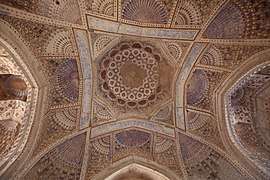 2009
2009 Traffic passing near the site.
Traffic passing near the site.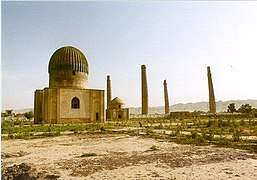 Ruined Gawhar Shad Mausoleum.
Ruined Gawhar Shad Mausoleum..jpg) Remaining minarets in 1939-40.
Remaining minarets in 1939-40.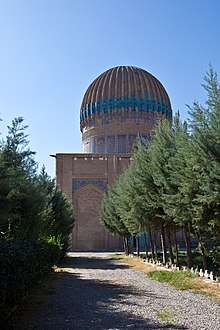 Musoleum in 2009.
Musoleum in 2009.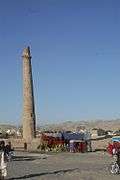 Vegetable Stands near the ruins in 2009.
Vegetable Stands near the ruins in 2009.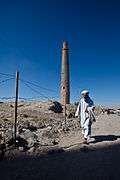 A minaret in 2009.
A minaret in 2009.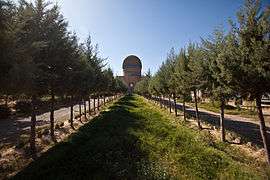 New replanted trees in complex garden in 2009.
New replanted trees in complex garden in 2009. Minaret in 1962.
Minaret in 1962.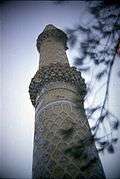 Minaret in 1969.
Minaret in 1969. The site in 1975.
The site in 1975.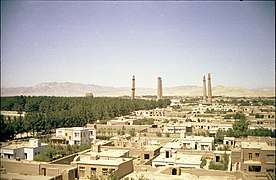 Herat skyline with Musallah minarets in 1969.
Herat skyline with Musallah minarets in 1969.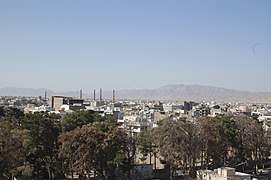 Herat skyline with Musallah minarets in 2009.
Herat skyline with Musallah minarets in 2009.
See also
References
- "Masjid-i Jami'-i Gawhar Shad - General view of the complex from west, with Gawhar Shad's Mausoleum seen at center and a canal in the foreground. The three minarets on the left marked the corners of Sultan Husain Baiqara's Madrasa, while the minaret at center once flanked the portal to Gawhar Shad's Madrasa. The two minarets seen on the right are the only remnants of Gawhar Shad's Mosque". Archnet.org. Retrieved 21 January 2019.
- "Mousallah Complex in Herat – Afghanistan – Tourist Spots Around the World". Touristspots.org. Retrieved 21 January 2019.
- "Afghanistan: Race To Preserve Historic Minarets Of Herat, Jam". Rferl.org. Retrieved 21 January 2019.
- "Tư vấn sản phẩm". Adventuretravelphotos.com. Retrieved 21 January 2019.